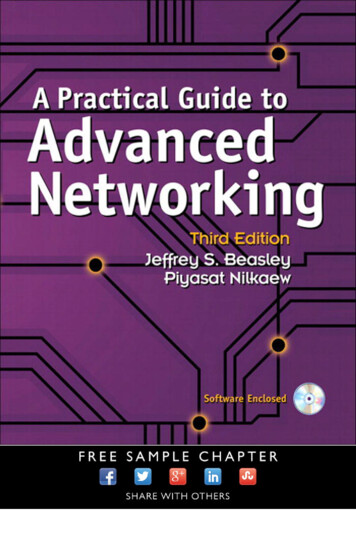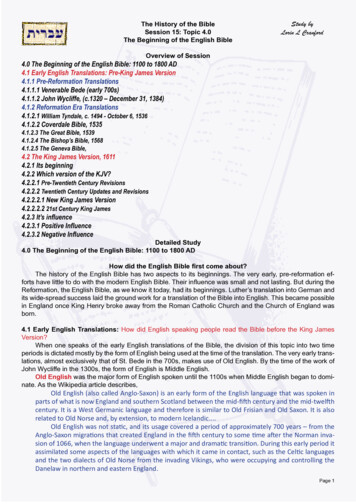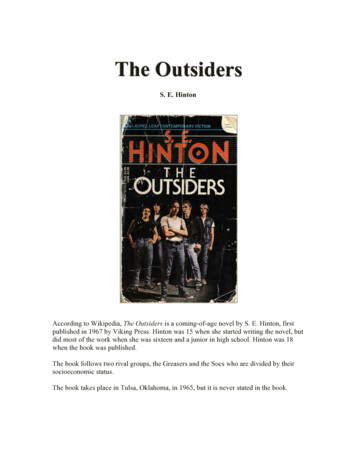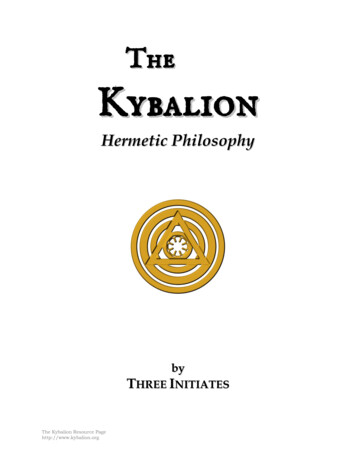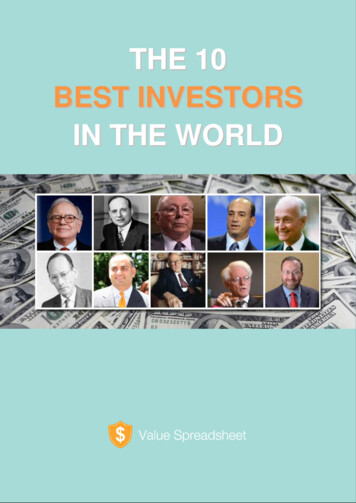
Transcription
THE 10BEST INVESTORSIN THE WORLD1www.valueinvestingbootcamp.com
Mildred Othmer died in 1998. Her husband, Donald Othmer, a professor of chemical engineering inBrooklyn, died three years earlier. Both were in their nineties. They lived quiet, unpretentious lives -which is why it came as a shock to their friends to learn that their combined estates were worth 800million and that they had given nearly everything to charity.How did the Othmers get so rich? Well, in the early 1960s, they each turned 25,000 over to WarrenBuffett, an old family friend from their hometown of Omaha, Nebraska Source: story2www.valueinvestingbootcamp.com
Introduction"We want the business to be one (a) that we understand; (b) with favorable long-term prospects; (c)operated by honest and competent people; (d) available at a very attractive price."Warren Buffett, sometimes called The Oracle of Omaha, is the most successful investor the world hasever seen. He amassed a fortune of no less than 64 billion USD, making him one of the richestpersons on earth. Buffett, who started with just 100, earned his fortune not through amazinginventions, or by starting his own successful business. Instead, he earned billions by simply investingin "wonderful companies" at "bargain prices". Sounds easy, huh? Maybe even too easy But timeand time again research finds that the majority of individual investors, as well as many professionalfund managers, consistently underperform benchmarks like the S&P500, while Buffett handsomelybeat every single benchmark available.During his time at Columbia Business School, Buffett studied under the legendary Benjamin Graham.Buffett learned from Graham to reduce a business to a set of numbers. These numbers could then beused to assess the so called intrinsic value of a company. Buying stocks of a company when they aretrading way below this intrinsic value has been the cornerstone of his investment strategy ever since.And judging from his impressive "compounded return" of 19,7% per year since 1965, this strategypaid off big time! If you had invested 10.000 in Buffett's investment vehicle Berkshire Hathaway in1965, you would today be the proud owner of more than 55 million dollar! That same amountinvested in the S&P500 would today be worth just over half a million.It is interesting to note that many of the best investors in the world share an investment strategysimilar to that of Buffett; a strategy called Value Investing. In this eBook I will introduce you to someof the world's best investors of all time! You'll learn who they are, why they are in this list, and whatthe focus of their investment strategies are.Enjoy!Nick KraakmanFounder of valuespreadsheet.comTable of ContentsWarren BuffettCharlie MungerJoel GreenblattJohn TempletonBenjamin GrahamPhilip FisherMohnish PabraiWalter SchlossPeter LynchSeth KlarmanFinal om
Warren Buffett (1930)"Whether we’re talking about socks or stocks, I like buying quality merchandisewhen it is marked down."Warren Buffett, born on August 30, 1930 in Omaha, Nebraska, is known as the world's best investorof all time. He is among the top three richest people in the world for several years in a row now,thanks to the consistent, mind-boggling returns he managed to earn with his investment vehicleBerkshire Hathaway. The funny thing is that Buffett does not even care that much about money.Investing is simply something he enjoys doing. Buffett still owns the same house he bought back in1958, hates expensive suits, and still drives his secondhand car.Investment philosophy: Focuses on individual companies, rather than macro-economic factorsInvests in companies with sustainable competitive advantagesPrefers becoming an expert on a few companies over major diversificationDoes not believe in technical analysisBases his investment decisions on the operational performance of the underlyingbusinessesHolds on to stocks for an extremely long period, some stocks he never sellsUses price fluctuations to his advantage by buying when undervalued and selling whenovervalued with respect to intrinsic valuePuts much emphasis on the importance of shareholder friendly, capable managementBelieves margin of safety are the three most important words in investing4www.valueinvestingbootcamp.com
Charlie Munger (1924)"All intelligent investing is value investing — acquiring more than you arepaying for."Charlie Munger is vice-chairman of Berkshire Hathaway, Warren Buffett's investment vehicle. Eventhough Buffett and Munger were born in Omaha, Nebraska, they did not meet until 1959. Aftergraduating from Harvard Law School, Munger started a successful law firm which still exists today. In1965 he started his own investment partnership, which returned 24.3% annually between 1965 and1975, while the Dow Jones only returned 6.4% during the same period. In 1975 he joined forces withWarren Buffett, and ever since that moment Charlie Munger has played a massive role in the successof Berkshire Hathaway. While Buffett is extroverted and a pure investor, Munger is more introvertedand a generalist with a broad range of interests. The fact that they differ so much from eachother is probably why they complement each other so well.Investment philosophy: Convinced Buffett that stocks trading at prices above their book value can still be interesting,as long as they trade below their intrinsic valueHas a multidisciplinary approach to investing which he also applies to other parts of his life("Know a little about a lot")Reads books continuously about varied topics like math, history, biology, physics, economy,psychology, you name it!Focuses on the strength and sustainability of competitive advantagesSticks to what he knows, in other words, companies within his "circle of competence"Believes it is better to hold on to cash than to invest it in mediocre opportunitiesSays it is better to be roughly right than precisely wrong with your predictions5www.valueinvestingbootcamp.com
Joel Greenblatt (1957)“Choosing individual stocks without any idea of what you’re looking for is likerunning through a dynamite factory with a burning match. You may live, butyou’re still an idiot.”Joel Greenblatt definitely knows how to invest. In 1985 he started his investment fundGotham Capital, and ten years later, in 1995, he had earned an incredible average return of 50%per year for his investors! He decided to pay his investors their money back and continued investingpurely with his own capital. Many people know Joel Greenblatt for his investment classic The LittleBook That Beats The Market* and his website magicformulainvesting.com. Greenblatt is also anadjunct-professor at the Columbia Business School.Investment philosophy: Buys good stocks when they are on salePrefers highly profitable companiesUses the Normalized Earnings Yield to assess whether a company is cheapBelieves thorough research does more to reduce risk than excessive diversification (heoften has no more than 8 companies in his portfolio)Largely ignores macro-economical developments and short term price movements*For your convenience I inserted Amazon links to the investment books mentioned in this document. Just to be transparent: these areaffiliate links. So if you decide to purchase the book through that link, I'll receive a small commission. The price for you remains exactly thesame. So if you click on any of 'em, thank you!6www.valueinvestingbootcamp.com
John Templeton (1912 -2008)"If you want to have a better performance than the crowd, you must do thingsdifferently from the crowd."The late billionaire and legendary investor, John Templeton, was born in 1912 as a member of a poorfamily in a small village in Tennessee. He was the first of his village to attend University, and he madethem proud by finishing economics at Yale and later a law degree at Oxford. Just before WWII,Templeton was working at the predecessor of the now infamous Merrill Lynch investment bank.While everyone was highly pessimistic during these times, Templeton was one of the few whoforesaw that the war would give an impulse to the economy, rather than grind it to a halt. Heborrowed 10.000 from his boss and invested this money in each of the 104 companies on the USstock market which traded at a price below 1. Four years later he had an average return of 400%! In1937, in times of the Great Depression, Templeton started his own investment fund andseveral decades later he managed the funds of over a million people. In 2000 he shorted 84technology companies for 200.000, he called it his "easiest profit ever". The beauty is thatdespite all his wealth, John Templeton had an extremely modest lifestyle and gave much of itaway to charitable causes.Investment philosophy: Contrarian, always going against the crowd and buying at the point of maximum pessimismHas a global investment approach and looks for interesting stocks in every country, butpreferably countries with limited inflation, high economical growth, and a movement towardliberalization and privatizationHas a long term approach, he holds on to stocks for 6 to 7 years on averageFocuses on extremely cheap stocks, not necessarily on "good" stocks with a sustainablecompetitive advantage, like Warren BuffettBelieves in patience, an open-mind, and a skeptical attitude towards conventional wisdomWarns investors about popular stocks everyone is buyingFocuses on absolute performance rather than relative performanceA strong believer in the wealth creating power of the free market economy7www.valueinvestingbootcamp.com
Benjamin Graham (1894 - 1976)"Price is what you pay, value is what you get."Columbia Business School professor Benjamin Graham is often called "The Father of Value Investing".He was also Warren Buffett's mentor and wrote the highly influential book The Intelligent Investor,which Buffett once described as the best book on investing ever written. Graham was born inEngland in 1894, but he and his family moved to the United States just one year later. His officialname was Grossbaum, but the family decided to change this German sounding name toGraham during the time of the First World War. Graham was a brilliant student and wasoffered several teaching jobs at the University, but instead he decided to work for a trading firmand would later start his own investment fund. Due to the use of leverage, his fund lost a whopping75% of its value between 1929 and 1932, but Graham managed to turn things around andmanaged to earn a 17% annualized return for the next 30 years. This was way higher than theaverage stock market return during that same period. In total, Graham taught economics for 28years at Columbia Business School.Investment philosophy: Focuses more on quantitative, rather than qualitative dataFirst step is to look for stocks trading below 2/3rd of net current asset value (NCAV)*Prefers companies which pay dividendsLooks for companies with a consistently profitable historyCompanies should not have too much long term debtEarnings should be growingIs willing to pay no more than 15 times the average earnings over the past three yearsDiversifies to spread the risk of individual positionsEmphasizes the importance of a significant Margin of SafetyProfits from irrational behavior caused by the manic-depressive "Mr. Market"Warns that emotions like fear and greed should play no role in your investment decisions*NCAV current assets - total liabilities8www.valueinvestingbootcamp.com
Philip Fisher (1907 - 2004)"I don't want a lot of good investments; I want a few outstanding ones."Philip Fisher became famous for successfully investing in growth stocks. After studyingeconomics at Stanford University, Fisher worked as an investment analyst before starting his ownfirm, Fisher & Co. This was in 1931, during the times of the Great Depression. Fisher's insights havehad a significant influence on both Warren Buffett and Charlie Munger. Philip Fisher is also authorof the powerful investment book Common Stocks and Uncommon Profits, which has a quote fromBuffett on its cover which reads: "I am an eager reader of whatever Phil has to say, and I recommendhim to you."Investment philosophy: Dislikes technical analysisDoes not believe in "market timing"Prefers a concentrated portfolio with around 10 to 12 stocksEmphasizes the importance of honest and able managementBelieves you should only invest in companies you can understandWarns that you should not follow the masses, but instead have patience and think foryourselfCompanies should have a strong business model, be innovative, highly profitable, andpreferably a market leaderHas a focus on growth potential of both companies and industriesBuys companies at "reasonable prices" but does not specify what "reasonable" is to himA true "buy & hold" investor who often holds on to stocks for decadesBelieves great companies purchased at reasonable prices and held for a long time are betterinvestments than reasonable companies bought at great pricesHas a "scuttlebutt" approach to doing research by asking questions to customers, employees,competitors, analysts, suppliers, and management to find out more about the competitiveposition of a company and its managementOnly sells when a company starts experiencing issues with its business model, competitivepositioning, or management9www.valueinvestingbootcamp.com
Mohnish Pabrai (1964)“Heads, I win; tails, I don’t lose much. “Mohnish Pabrai has once been heralded as "the new Warren Buffett" by the prestigious Americanbusiness magazine Forbes. While this seems like big words, you might start to understand whyForbes wrote this when you look at the performance of Pabrai's hedge funds, Pabrai InvestmentFunds, which have outperformed all of the major indices and 99% of managed funds. At least, thatwas before his funds suffered significant losses during the recent financial crisis because of theirexposure to financial institutions and construction companies. Still, there is much we can learn fromhis low-risk, high-reward approach to investing, which he describes in his brilliant book The DhandhoInvestor: The Low-Risk Value Method to High Returns.Investment philosophy: Points out that there is a big difference between risk and uncertaintyLooks for low-risk, high-uncertainty opportunities with a significant upside potentialOnly practices minor diversification and usually has around 10 stocks in his portfolioBelieves stock prices are merely "noise"Used to buy reasonable companies at great prices, but now wants to focus more on qualitycompanies with a sustainable competitive advantage and shareholder friendlymanagement10www.valueinvestingbootcamp.com
Walter Schloss (1916 - 2012)"If a stock is cheap, I start buying."While Walter Schloss might not be the most well-known investor of all time, he was definitely one ofthe best investors of all time. Just like Buffett, Walter Schloss was a student of Benjamin Graham.Schloss is also mentioned as one of the "Super Investors" by Buffett in his must-read essay The SuperInvestors of Graham-And-Doddsville. An interesting fact about Walter Schloss is that he never wentto college. Instead, he took classes taught by Benjamin Graham after which he started working forthe Graham-Newton Partnership. In 1955 Schloss started his own value investing fund, which he ranuntil 2000. During his 45 years managing the fund, Schloss earned an impressive 15.3% return versusa return of 10% for the S&P500 during that same period. Just like Warren Buffett and JohnTempleton, Walter Schloss was known to be frugal. Schloss died of leukemia in 2012 at age 95.Investment philosophy: Practiced the pure Benjamin Graham style of value investing based on purchasing companiesbelow NCAVGenerally buys "cigar-butt" companies, or in other words companies in distress which aretherefore trading at bargain pricesRegularly used the Value Line Investment Survey to find attractive stocksMinimizes risk by requiring a significant Margin of Safety before investingFocuses on cheap stocks, rather than on the performance of the underlying businessDiversified significantly and has owned around 100 stocks at a timeKeeps an open mind and even sometimes shorts stocks, like he did with Yahoo and Amazonjust before the Dot-Com crashLikes stocks which have a high percentage of insider ownership and which pay a dividendIs not afraid to hold cashPrefers companies which have tangible assets and little or no long-term debt11www.valueinvestingbootcamp.com
Peter Lynch (1944)"Everyone has the brain power to make money in stocks. Not everyone has thestomach."Peter Lynch holds a degree in Finance as well as in Business Administration. After University, Lynchstarted working for Fidelity Investments as an investment analyst, where he eventually got promotedto director of research. In 1977, Peter Lynch was appointed as manager of the Magellan Fund, wherehe earned fabled returns until his retirement in 1990. Just before his retirement he published thebestseller One Up On Wall Street: How To Use What You Already Know To Make Money In TheMarket. Just as many of the other great investors mentioned in this document, Lynch took upphilanthropy after he amassed his fortune.Investment philosophy: You need to keep an open mind at all times, be willing to adapt, and learn from mistakesLeaves no stone unturned when it comes to doing due diligence and stock researchOnly invests in companies he understandsFocuses on a company's fundamentals and pays little attention to market noiseHas a long-term orientationBelieves it is futile to predict interest rates and where the economy is headingWarns that you should avoid long shotsSees patience as a virtue when it comes to investingEmphasizes the importance of first-grade managementAlways formulates exactly why he wants to buy something before he actually buyssomething12www.valueinvestingbootcamp.com
Seth Klarman (1957)“Once you adopt a value-investment strategy, any other investment behaviorstarts to seem like gambling.“Billionaire investor and founder of the Baupost Group partnership, Seth Klarman, grew up inBaltimore and graduated from both Cornell University (economics) and the Harvard Business School(MBA). In 2014 Forbes mentioned Seth Klarman as one of the 25 Highest-Earning hedge fundmanagers of 2013, a year in which he generated a whopping 350 million return. Klarman generallykeeps a low profile, but in 1991 he wrote the wrote a book Margin of Safety: Risk Averse InvestingStrategies for the Thoughtful Investor, which became an instant value investing classic. This book isnow out of print, which has pushed the price up to over 1500 for a copy! Is extremely risk-averse and focuses primarily on minimizing downside riskDoes not just look for cheap stocks, but looks for the cheapest stocks of great companiesWrites that conservative estimates, a significant margin of safety, and minor diversificationallow investors to minimize risk despite imperfect informationWarns that Wall Street, brokers, analysts, advisors, and even investment funds are notnecessarily there to make you rich, but first and foremost to make themselves richOften invests in "special situations", like stocks who filed for bankruptcy or risk-arbitragesituationsSuggests to use several valuation methods simultaneously, since no method is perfect andit is impossible to precisely calculate the intrinsic value of a companyIs known for holding a big part of his portfolio in cash when no opportunities existBelieves investors should focus on absolute performance, rather than relative performanceEmphasizes that you should find out not only if an asset is undervalued, but also why it isundervaluedIs not afraid to bet against the crowd and oppose the prevailing investment windsDiscourages investors to use stop-loss orders, because that way they can't buy more of agreat thing when the price declines13www.valueinvestingbootcamp.com
Final wordsI hope you enjoyed reading how some the best investors in the world think about investing. Youmight have noticed some common themes, like buying companies for less than they are worth. Andwhile all investors discussed in this eBook practice this value investing approach, there arealso notable differences between the strategies of these masters of investing.Where Warren Buffett runs a concentrated portfolio and focuses on "good" companies witha sustainable competitive advantage, which is the strategy I mainly focus on in my ValueInvesting Bootcamp video course, Walter Schloss managed to earn impressive returns by simplybuying a diverse set of extremely cheap companies.As Bruce Lee once said:"Adapt what is useful, reject what is useless, and add what is specifically your own.”Good luck!About the authorNick Kraakman is a value investing expert, serial entrepreneur, educator,blogger and public speaker who helps other investors to consistently grow theirwealth using a simple, low-risk, time-tested value investing strategy.14www.valueinvestingbootcamp.com
In this eBook I will introduce you to some of the world's best investors of all time! You'll learn who they are, why they are in this list, and what . Seth Klarman 13 Final words 14 . 4 www.valueinvestingbootcamp.com Warren Buffett (1930) . Believes margin of safety are the three most important words in investing. 5 .

